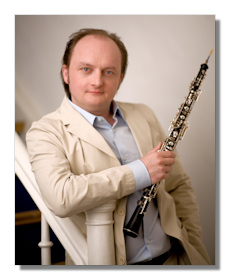
The Internet's Premier Classical Music Source
Related Links
- Latest Reviews
- More Reviews
-
By Composer
-
Collections
DVD & Blu-ray
Books
Concert Reviews
Articles/Interviews
Software
Audio
Search Amazon
Recommended Links
Site News
 Concert Review
Concert Review
Hungarian Magic

- Antonino Pasculli:
- Concerto on Themes from Donizetti's "La Favorita"
- Wolfgang Mozart:
- Concerto for Oboe & Orchestra in C Major, K. 314
- Franz Liszt:
- A Faust-Symphony
François Leleux, oboe
Budapest Festival Orchestra, Iván Fischer
Brussels, Centre for Fine Arts, 6 March 2013
The Budapest Festival Orchestra is celebrating its 30th anniversary this year. Under the guidance of maestro Iván Fischer (co-founder with Zoltán Kocsis), the orchestra not only established itself as one of Hungary's foremost cultural entities, it also went on to cut a strong profile on the international stage. The program they offered in Brussels was delightfully unusual and of the highest level throughout. Starting with a small oboe festival with pieces from the little-known Pasculli and Mozart, featuring the high-spirited François Leleux as soloist, it was the rarely heard Faust-Symphony from Franz Liszt which acted as the focal point of the evening.
Sicilian Antonino Pasculli (1842-1924) enjoyed a rather brief career as a performing artist, touring Italy and parts of Europe as the "Paganini of the oboe", before settling down in his hometown Palermo to teach and raise a family. His compositions apparently harbored but one ambition: to demonstrate his instrumental virtuosity. And that's what they did judging by his Concerto on themes from Donizetti's "La Favorita".
François Leleux enjoys a busy career as principal oboe of the Chamber Orchestra of Europe and is an active soloist, chamber musician, conductor, and teacher. Moreover, he is quite a magical performer. His sonority is totally enchanting, his virtuosity limitless and flows so naturally from its source that one is no longer aware of all the hard work that preceded it. Whether it is in the flowery virtuoso pranks of Pasculli or the elegance, lyricism and joie de vivre of Mozart's concerto, Leleux's commitment is irresistible. Standing at the side of the conductor, he spices his playing with an appropriate dose of showiness and wit, knowing exactly how far to go. Yet as his rendition of the Mozart C major concerto proved, he is also a sensitive artist, a subtle colorist, dialoguing and blending his instrument with the orchestral textures to ravishing effect – with Fischer and the Budapest strings offering the most sympathetic accompaniment. The tender melancholy of Mozart's Andante ma non troppo was as compellingly rendered as the three dazzling cadenzas.
An enraptured audience was rewarded by Leleux with an Air from Gluck's Orfeo ed Euridice.
After the break the Budapest Festival Orchestra fully came into its own with a magnificent traversal of A Faust-Symphony. Focused but clearly enjoying this music, Fischer and his orchestra imaginatively and precisely captured Liszt's psychological evocations: Faust's virility, complexity and indecision, Gretchen's innocence and growing passion, Mephistopheles sardonic denial. The work is still often slighted as overlong, strained and even coarse. No trace of any of that here. With the architecture convincingly held together, the often remarkable orchestration honored at every bar and the emotional content superbly shaded, Fischer and his ensemble gave ample proof that this is by far the most accurate and concise musical synthesis of Goethe's imagination, and indeed a pinnacle of 19th-century symphonic writing. My only regret was that Fischer performed the symphony in its original 1854 version, before the composer added the "'Chorus mysticus" finale for tenor and male voices, crowning the triad with a quote from Goethe's play and thus adding a spiritual dimension to the essentially human conflicts depicted in the preceding movements.
By an unusual placement of the orchestra Fischer not only obtained a convincing balance but also a vivid stereo, almost three-dimensional sound effect in the hall. Brass and violins were divided left and right, but the double basses were placed in the center, at the back on a platform, creating with the cellos a rock-solid base and adding to the dark, brooding mood of much of the symphony. The playing of the Budapest Festival Orchestra was outstanding. Liszt's multilayered string textures were superbly realized, transparent, warm, without any shrillness in the most demanding passages. The colorful winds were breathtakingly beautiful, refined and individual – the first bassoon, oboe and flutes especially – having their moment of glory in the 2nd movement. The brass and percussion were powerful but disciplined.
The Budapest Festival Orchestra has been granted a place in the top ten of the world's best ensembles. There is little doubt this is duly justified.
Copyright © 2013, Marc Haegeman












